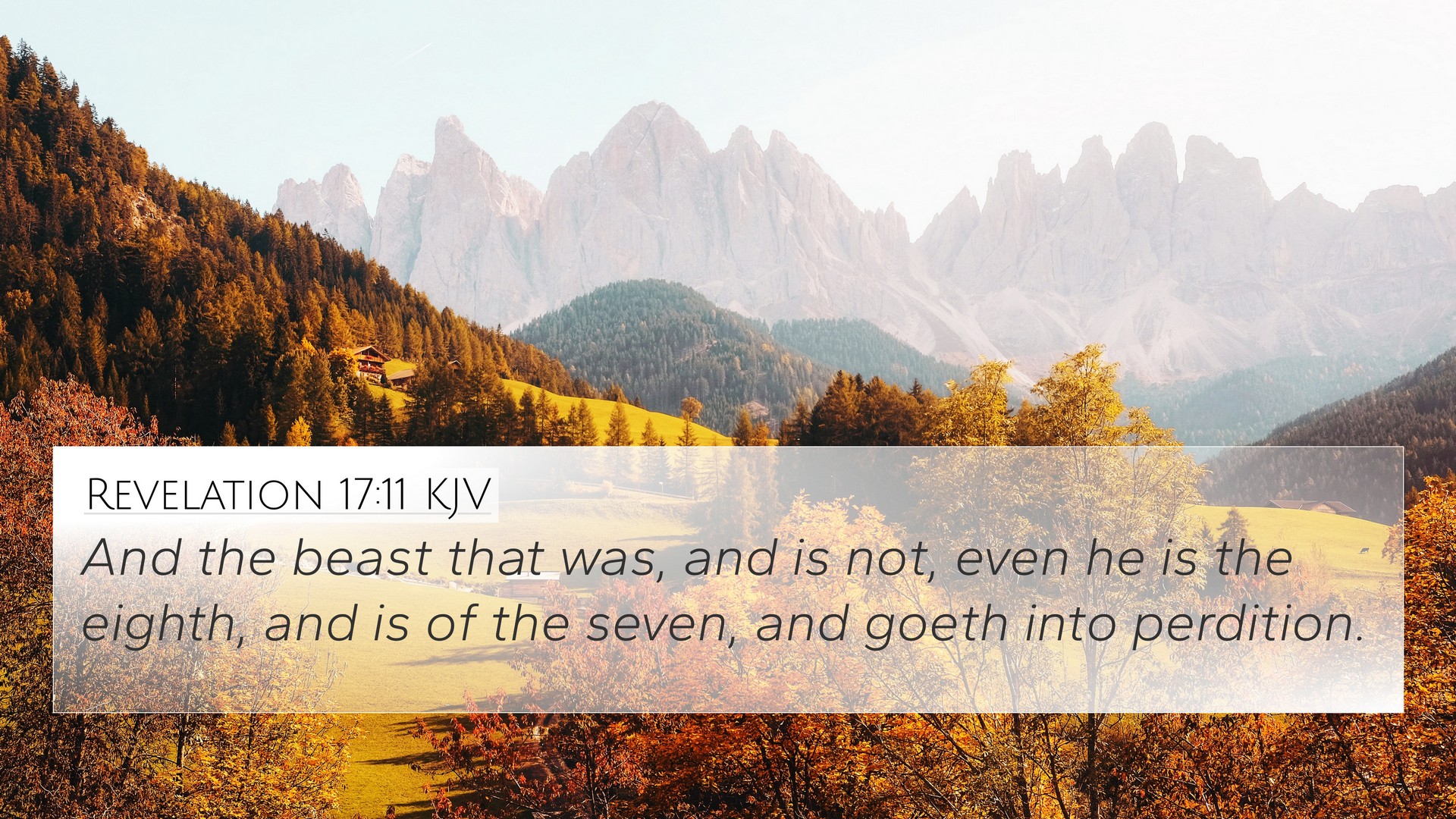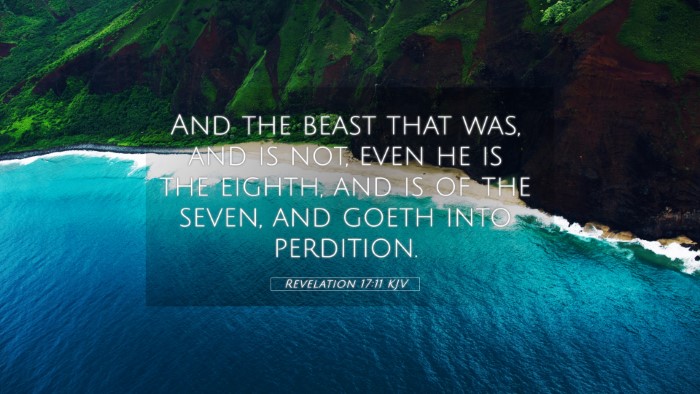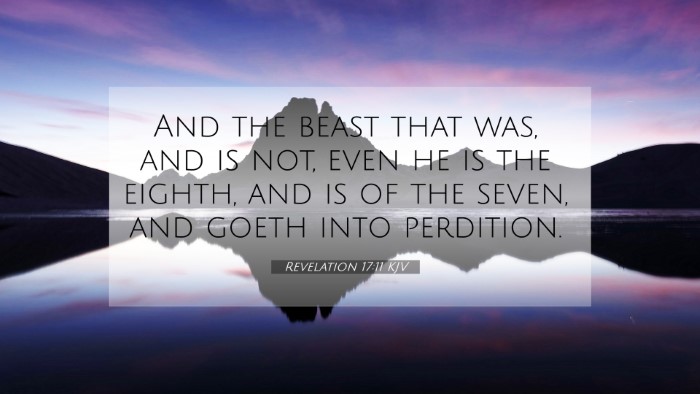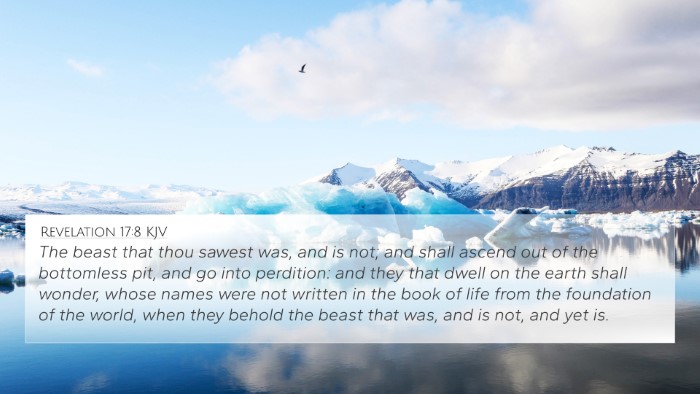Understanding Revelation 17:11
Revelation 17:11 states: "And the beast that was, and is not, even he is the eighth, and is of the seven, and goeth into perdition." This verse is rich in imagery and significance, representing themes of power, apostasy, and judgment throughout the biblical narrative.
Summary of Verse Meaning
This verse speaks about a beast that embodies contrasting states of existence: it "was," it "is not," and it will become the eighth in a line that precedes it, ultimately leading to destruction. Here’s a summary of its implications based on public domain commentaries:
Insights from Commentaries
-
Matthew Henry:
Henry explains that the beast symbolizes a political power that appears to be both past and present, suggesting a cyclical nature of empires. The reference to "the eighth" signifies a culmination of earthly powers, yet it inevitably leads to judgment.
-
Albert Barnes:
Barnes elaborates on the idea that the beast represents a form of rebellious power against God. The beast's transition from being to non-being and its role in the apocalypse showcases God's sovereignty over earthly dynasties.
-
Adam Clarke:
Clarke focuses on the eschatological aspects of the beast's identity. He suggests that the beast could be an individual or a system, perhaps linked to historical antichrists. Its fate in "perdition" underscores the ultimate triumph of good over evil.
Bible Verse Cross-References
Revelation 17:11 can be cross-referenced with several other scriptural passages to enhance understanding. Here are some notable connections:
- Daniel 7:7-8: Discusses the four beasts symbolism, paralleling the theme of monstrous power.
- Revelation 13:1: Describes a beast rising from the sea, emphasizing similar imagery of political power.
- 2 Thessalonians 2:3-4: Refers to the man of sin who opposes and exalts himself, akin to the characteristics of the beast.
- Isaiah 14:12-15: This passage details the fall of the king of Babylon, reflecting the theme of pride leading to destruction.
- Romans 16:20: Suggests that God will soon crush Satan, reassuring believers of the ultimate victory over evil forces.
- John 17:12: Mentions a son of perdition, hinting at a similar destiny concerning those in opposition to God.
- Revelation 20:10: Concludes the power of the beast and false prophet in the lake of fire, culminating in their eternal judgment.
Thematic Bible Verse Connections
Several themes emerge from the analysis of Revelation 17:11 and its cross-references:
- Judgment: The notion of sin leading to perdition is common across these scriptures.
- Authority and Power: The rise and fall of empires and leaders are recurrent, illustrating God's sovereignty.
- Apocalyptic Literature: Many verses, such as those in Daniel and the Gospels, explore the end times and the finality of evil's fate.
- Hope and Assurance: Despite the grim depiction, verses like Romans 16:20 reaffirm the eventual victory of God over evil.
Connections Between Bible Verses
The analysis of Revelation 17:11 and related verses reveals an intricate web of biblical narratives and themes:
By exploring these connections, believers can understand how cross-referencing biblical texts enriches their study of scripture and deepens their comprehension of essential concepts.
Tools and Methods for Bible Cross-Referencing
For readers interested in conducting their bible cross-reference studies, here are some recommended methods:
- Utilize a bible concordance to find keywords and themes.
- Refer to a bible cross-reference guide provided in study Bibles.
- Engage in comparative studies of relevant verses to discover thematic parallels.
- Build a personal bible reference resource by listing verses that connect.
- Employ tools such as bible cross-reference systems to facilitate deeper study.
Conclusion
In summary, Revelation 17:11 presents a complex portrayal of the beast as a representation of temporal power ultimately doomed for destruction. These insights, coupled with relevant cross-references, form a foundation for understanding biblical themes of judgment, power, and hope that resonate throughout scripture.



